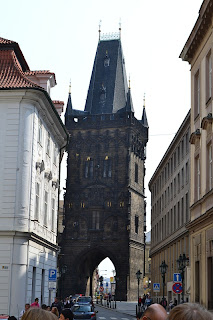Ou Dorp, Praag
Die ou dorp is in die hartjie van Praag, en het sy ontstaan in die 9de eeu gehad. Rekords dui aan dat daar al vanaf die 1100's op Saterdae markte gehou is, en groot millitêre byeenkomste is ook daar gehou. In die begin is dit deur 'n halfsirkel moot en muur wat gegrens het aan die Vltava rivier van die buitewereld afgesonder, maar met die onstaan van die Nuwe Dorp in die 14de eeu, is dit opgebreek.
I am doing this post in a splash of golden sunshine, in my own home. Around me the cats are soaking up some son, and I have a pot of tea at my elbow. It's so good to be back- though I left a piece of my heart behind in the Czech Republic. I wrote this post in Prague, but I still had to add some finishing touches- shrinking the pictures, adding the links and checking spelling and grammar. But enough said about that, let me tell you about
Old Town Prague
From its early existence, around 9th century, Old
Town was laid out of settlements
which appeared from the spacious marketplace on the bank of Vltava.
Records dating back to 1100AD indicate that every Saturday a market was held on
the marketplace, and large military gatherings also took place there. It was
separated from the outside by a semi-circular moat and wall, connected to the Vltava at both of
its ends. After the city was expanded in the 14th century by Charles IV with the founding of the New
Town, the moat and wall were dismantled soon after.
Elke uur is daar 'n samedromming van mense op die plein wat hulle vergaap aan skouspel van die astronomiese horlosie wat die uur met groot fanfare aankondig. Eers lui 'n geraamte, of te wel, die dood 'n klokkie, en dan verskyn uitbeeldings van die twaalf Apostels een na die ander in die venstertjies bokant die horlosie. Die horlosie slaan, en iemand in middelseeuse klere blaas 'n beul bo-op die toring.
Die indrukwekkende horlosie is in 1410 geïnstalleer. Dis die derde oudste astrononmiese horlosie in die wereld, en dis oudste een wat steeds werk.
Die werking van die horlosie is te ingewikkeld vir my om te verduidelik (of te verstaan) maar as jy meer daaroor wil weet, gaan lees hier. Om die uurlikse vertoning te sien, gaan kyk hier.
Every hour, on the hour, masses gather on the town square, to watch the clock. The Prague Astronomical Clock is a medieval astronomical clock mounted on the South facing wall of the city hall, situated on the Old Town Square. The clock was first installed in 1410, making it the third-oldest
astronomical clock in the world and the oldest one still working.
The clock mechanism itself is composed of three main components: the astronomical dial, representing the position of the sun and moon in the sky and displaying various astronomical details; "The Walk of the Apostles", a clockwork hourly show of figures of the Apostles and other moving sculptures—notably a figure of Death (represented by a skeleton) striking the time; and a calendar dial with medallions representing the months.
The mechanics of this clock is too complicated for me to try to explain- if you are interested to know how it works, have a look here, and here if you want to watch the hourly spectacle.
The mechanics of this clock is too complicated for me to try to explain- if you are interested to know how it works, have a look here, and here if you want to watch the hourly spectacle.
Op baie van die geboue pryk simbole van die families wat daar gewoon het. Hier het drie families van vioolmakers gewoon:
Jou adres was dan iets soos "At the golden ring",
Your adress then was something like "At the golden Ring",
Or "At the golden snake"
of "At the stone bird"
or "At the stone bird"
En hier sou ons gebly het!
This is where we would have lived!
"By die befoeterde beer"
"At the grumpy bear"
Hierdie is 'n Gotiese venster wat oorgebly het van die oudste universiteit in sentraal Europa, Charles Universiteit, wat deur Karl IV begin is. Die Veertiende-eeuse gebou is in 1945 deur die Duitsers vernietig.
Charles University was the first university in Central Europe, founded by Emperor Karl IV. Unfortunately, the original XIV century building was destroyed by the Germans in 1945, and only the gothic window has survived.
"Die spook van Don Giovanni" buite die ingang van die Estate Teater. Die Opera "Don Giovanni" het in 1787 hier geopen, en is deur Mozart self gederigeer.
The statue of the ghost of Don
Giovanni to the left of the Estate Theatre entrance. This theatre premiered the
famous Opera, Don Giovanni, conducted by none other than W.A.Mozart himself in
1787.
"Powder Tower' was een van die ingange na die stad in die 15de eeu. Die naam dateer uit die 17de eeu toe die toring as stoorplek vir buskryt gebruik is.
Powder Tower was one of the several entrances to the city in 15th century. Origins of its name date back to the 17th century when the tower was used to store gun powder.
Dis dan my storie oor die Ou Dorp. Natuurlik kan ek nie alles vertel nie. Maak nie saak watter woorde ek kies, of watter foto's ek wys nie, niks kan die werklike karakter vasvang nie. As ek 'n horlosie hoor slaan, maak ek my oë toe, en word teruggevoer na vreemde stemme, musiek, perdepote op kilpstrate, en geure van koffie en kaneel.
Try as I might, I will never be able to capture the essence of the golden city. But when a clock strikes the hour, I close my eyes, and I can hear the forreign voices, the music, the clippety clop of horsesfeet on cobbled streets, and the aroma's of coffee and cinemon.












Geen opmerkings nie:
Plaas 'n opmerking